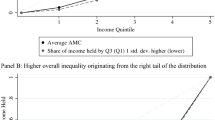Abstract
Using the latest available data and semiparametric methods, we investigate how human and physical capital accumulation affects the relationship between income inequality and subsequent economic growth. We find that higher income inequality generally reduces economic growth over the next 5-year period. Within nations possessing little human capital, this inequality-growth penalty is exacerbated by higher levels of physical capital, thus implying that as the returns to human capital rise relative to physical capital, inequality becomes more harmful to growth. This inequality-growth pattern does not hold in well educated nations.
Similar content being viewed by others
References
Arellano, M., Bond, S.: Some tests of specification for panel data: Monte Carlo evidence and an application to employment equations. Rev. Econ. Stud. 58, 277–297 (1991)
Alesina, A., Perotti, R.: Income distribution, political instability and investment. Eur. Econ. Rev. 81, 1170–1189 (1996)
Alesina, A., Rodrik, D.: Distributive politics and economic growth. Q. J. Econ. 109, 465–490 (1994)
Atkinson, A., Brandolini, A.: Promise and pitfalls in the use of ‘Secondary’ data-sets: income inequality in OECD countries as a case study. J. Econ. Lit. 39, 771–799 (2001)
Barro, R.J., Lee, J.: International data on educational attainment: updates and implications. Center for International Development, Harvard University, Working Paper No. 42. http://www.cid.harvard.edu/ciddata/ciddata.html (2000)
Benabou, R.: Heterogeneity, stratification, and growth: macro implications of community structure and school finance. Am. Econ. Rev. 86, 584–609 (1996)
Berg, M.D., Li, Q., Ullah, A.: Instrumental variable estimation of semiparametric dynamic panel data models: Monte Carlo results on several new and existing estimators. Nonstationary Panels, Panel Cointegration and Dynamic Panels 15, 297–315 (2000)
Bertola, G.: Factor shares and savings in endogenous growth. Am. Econ. Rev. 83, 1184–1198 (1993)
Deininger, K., Squire, L.: New data set measuring income inequality. World Bank Econ. Rev. 10, 565–591 (1996)
Duffy, J., Papageorgiou, C., Perez-Sebastian, F.: Capital-skill complementarity? Evidence from a panel of countries. Rev. Econ. Stat. 86, 327–333 (2004)
Forbes, K.J.: A reassessment of the relationship between inequality and growth. Am. Econ. Rev. 90, 869–887 (2000)
Galor, O., Moav, O.: From physical to human capital accumulation: inequality and the process of development. Rev. Econ. Stud. 71, 1001–1026 (2004)
Galor, O., Tsiddon, D.: Technological progress, mobility, and economic growth. Am. Econ. Rev. 87, 363–382 (1997)
Galor, O., Zeira, J.: Income distribution and macroeconomics. Rev. Econ. Stud. 60, 35–52 (1993)
Greenwood, J., Jovanavic, B.: Financial development, growth and the distribution of income. J. Polit. Econ. 98, 1076–1107 (1990)
Heston, A., Summers, R., Aten, B.: Penn World Table Version 6.2, Center for International Comparisons of Production, Income and Prices, University of Pennsylvania. http://pwt.econ.upenn.edu/ (2006)
Jain, S.: Size Distribution of Income: A Comparison of Data. The World Bank, unpublished manuscript (1975)
Kaldor, N.: A model of economic growth. Econ. J. 67, 591–624 (1957)
Keynes, J.M.: The General Theory of Employment, Interest, and Money. Harcourt, Brace and World, New York (1936)
Li, Q., Racine, J.S.: Nonparametric Econometrics. Princeton University Press, Princeton (NJ) (2007)
Li, Q., Stengos, T.: Semiparametric estimation of partially linear panel data models. J. Econom. 71, 389–397 (1996)
Li, H., Zou, H.-F.: Income inequality is not harmful for growth: theory and evidence. Rev. Dev. Econ. 2, 318–334 (1998)
Pagan, A., Ullah, A.: Nonparametric Econometrics. Cambridge University Press, Cambridge (1999)
Perotti, R.: Political equilibrium, income distribution and growth. Rev. Econ. Stud. 60, 755–776 (1993)
Perotti, R.: Growth, income distribution, and democracy: what the data say. J. Econ. Growth 1, 149–187 (1996)
Persson, T., Tabellini, G.: Is inequality harmful for growth? Theory and evidence. Am. Econ. Rev. 84, 600–621 (1994)
Robinson, P.M.: Root-N-Consistent semiparametric regression. Econometrica 56, 931–954 (1988)
Smith, A.: An inquiry into the nature and causes of the wealth of nations, 5th edn, 1904. Methuen & Co., Ltd, London. http://www.econlib.org/library/Smith/smWNCover.html (1776)
UNU-WIDER: World Income Inequality Database, Version 2.0c (2008)
Author information
Authors and Affiliations
Corresponding author
Additional information
We would like to thank Oded Galor, Jang-Ting Guo, Lant Pritchett, Daniel Henderson, Aman Ullah, and two anonymous referees for their helpful comments, discussions, and suggestions. All remaining errors are our own.
Rights and permissions
About this article
Cite this article
Chambers, D., Krause, A. Is the relationship between inequality and growth affected by physical and human capital accumulation?. J Econ Inequal 8, 153–172 (2010). https://doi.org/10.1007/s10888-009-9111-x
Received:
Accepted:
Published:
Issue Date:
DOI: https://doi.org/10.1007/s10888-009-9111-x




